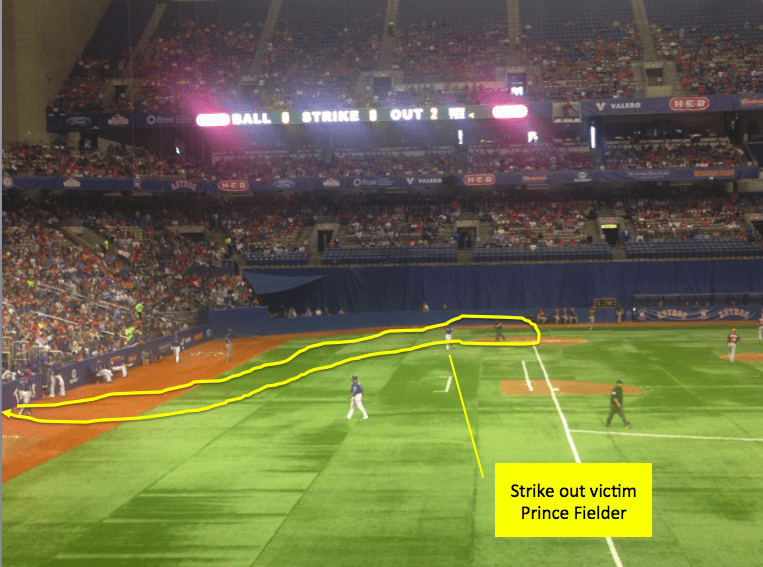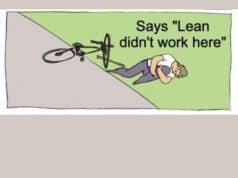I found a picture (posted by Jamie Voster on LinkedIn) and I re-shared it through my account. Neither Jamie nor I know where the picture was taken or who took it (I wish I could do a better job of giving credit).
Anyway, here is the great picture and the quote, attributed to the late Rear Admiral Grace Hopper.

She sounds like she was quite an amazing woman – she is credited with coining the term “debugging” a computer system. Read more of her quotes and wisdom here.
“We've always done it this way” is certainly a commonly-said phrase.
When I hear it, in the context of Lean, kaizen, or problem solving, it's a red flag, time out moment. Wait, let's stop and talk about that.
When we ask what we've always done that way or why we've always done it that way, sometimes there is a good reason. If so, we should understand WHY we are doing something that way and ask if we really should continue it that way. Should we tweak the way we do it and make it slightly better?
Sometimes, we shouldn't be doing it that way and we shouldn't continue. Can we find a better way of doing something? Should we reinvent the process and method instead of just tweaking it?
Those are all judgment calls and there's no substitute for thinking and talking about it as a team.
Now, I'm going to shift from the Navy world (which I know nothing about) to the world of baseball.
I attended an exhibition (“pre-season”) game yesterday in San Antonio – the Rangers vs. Astros. They had to awkwardly cram a baseball field into a stadium built for football (how they did it in 2013). That led to the right-field wall being just 271 feet from home plate, which is extremely short.
You can tell how close I was to home plate:

A line shot foul ball could get out there pretty quickly. There was thankfully a boy to my right with a baseball glove and another boy with a glove to the left of my wife. I'm too old to wear or bring a baseball glove to a game, I think (although I did as a kid).
In the right side of the picture, you can see what's normally called “the foul pole.” It's normally a solid pole that comes up from the ground or from the fence. In terms of operational definitions, the pole is misnamed because a ball that strikes it is actually a fair ball. Go figure.
Why is it normally a pole? They've always done it that way. Well, in the Alamodome, they hung a ribbon down from the ceiling. Why, because they have a roof. Is it different than the way we normally do it? Sure. Was it better? Maybe. But it worked (or seemed to work).
Cramming a baseball field into a football stadium solved one problem (“We can't host a major league game in San Antonio”) but it created other problems. There were a few “cheap shot” home runs to right field and right center… but it's just an exhibition game. No major league team would make this their regular home.
But, solving one problem created other problems. We see this a lot when we have workplace spaces that don't serve our people and processes well (see the design problems in many hospitals and clinic spaces that lead to inefficiency for staff and patients).
Last year, the left field wall at the Alamodome was really FAR for from home plate. So, they solved that this year by moving home plate further toward right field (to the right looking at the picture above). This caused another problem of making right field even shorter than it was last year.
We see this a lot – you solve one problem and cause another. That's why we tend to use the term “countermeasure” instead of “solution.”
By moving home plate, they created a very asymmetrical field, where the Rangers' “dugout” (along the first base line) was a lot further from the field than the Astros' “dugout” on the third base side. I put “dugout” in quotes because neither one was really a dugout that would normally be a few steps below field level. Why is it always that way? Probably for a number of really good reasons.
The long distance between the dugout and home plate created a bad “spaghetti diagram” and a really low slow walk back if you struck out. A walk of shame, eh?

Baseball, generally, has a mixed record on fixing “we've always done it that way” issues.
Base coaches never wore hard helmets. They'd always done it that way. Then, a minor league coach was killed by a foul ball to the head, so MLB changed the rule. That was reactive.
Can baseball be more proactive? There's a known risk of a pitcher being hit in the head and killed by a line drive. There are many close calls, including the recent one with Aroldis Chapman was hit. Baseball has consider allowing (or requiring) pitchers to wear better protection, but they've moved slowly… I'd hate to see them wait until a pitcher gets killed to react. Why don't pitchers wear protection? Part of it is “we've always done it that way.”
The padded caps have been approved by MLB but nobody is wearing them now. Pitchers are being “resistant to change” (I hate that expression), because they say the caps are too bulky. MLB could FORCE them to wear them (I'm sure the base coaches complained) or they could keep up the product development work to get a cap pitchers will choose to wear.
I'm not a big fan of top-down management pronouncements, but sometimes safety has to come first. Do we let factory workers choose if they wear safety glasses and other PPE? No. If MLB forced pitchers to wear them, they'd do well to explain “why” that's necessary. But, they might still end up with unhappy employees and a labor relations issue.
There are often no easy answers to the question of “should we always do it this way?”
What is happening in your workplace?
Please scroll down (or click) to post a comment. Connect with me on LinkedIn.
Let’s work together to build a culture of continuous improvement and psychological safety. If you're a leader looking to create lasting change—not just projects—I help organizations:
- Engage people at all levels in sustainable improvement
- Shift from fear of mistakes to learning from them
- Apply Lean thinking in practical, people-centered ways
Interested in coaching or a keynote talk? Let’s start a conversation.







![When Was the Last Time a Leader Around You Admitted They Were Wrong? [Poll]](https://www.leanblog.org/wp-content/uploads/2025/07/Lean-Blog-Post-Cover-Image-2025-07-01T212509.843-100x75.jpg)


Yes…this phrase sums up a great deal of the attitude that was and is out there.
Fortunately, with new people comes new technology, knowledge, ideas and attitude that can help with this mind block.
Mark,
I worked with many clients and in many industries. This comment normally comes from the employee or the supervisor who is not being held accountable. All these years they been able to come to work and pace their day. Normally when I get this comment from a Supervisor I asked him/her “So, is that good or bad?” “Show me the data that would prove that you had a good day or bad day?” The supervisor normally does not have the data but the point I normally make is “how do you know if by doing the activities you normally do, if it is good or bad?”
I think “being held accountable” is an interesting topic. Like you said, if people don’t have meaningful measures that help them know if they’re having a “good day” or a “bad day,” they can’t really even choose to be accountable. This is a real problem in most hospitals – did we have a good day or a bad day? It was just a busy day.
[…] Fighting “We’ve Always Done It This Way” in Workplaces & Baseball by Mark Graban. “When we ask what we’ve always done that way or why we’ve always done it that way, sometimes there is a good reason. If so, we should understand WHY we are doing something that way and ask if we really should continue it that way. . . Sometimes, we shouldn’t be doing it that way and we shouldn’t continue. Can we find a better way of doing something? Should we reinvent the process and method instead of just tweaking it?” […]
This photo is taken from inside the Information Commissioners Office (ICO)
Thanks, Peter — this organization?
[…] Image found here. […]
[…] from Fighting “We’ve Always Done It This Way” in Workplaces & Baseball by Mark Graban […]
[…] from Fighting “We’ve Always Done It This Way” in Workplaces & Baseball by Mark Graban […]